System Dynamics Modeling for Effective Strategies in Water Pollution Control: Insights and Applications
Abstract
:1. Introduction
Research Objective
2. Materials and Methods
2.1. Data Collection
2.2. Model Development and Validation
2.3. Policy Analysis
2.4. Limitations
2.5. Study Area
3. Results and Discussion
3.1. Conceptual and General Scheme of the System
3.2. Stock-Flow Diagram
3.3. Model Calibration and Verification
3.3.1. Historical Data
3.3.2. Structure Assessment Test
3.3.3. Extreme Condition Test
3.4. Scenario Analysis
3.4.1. Scenario 1: Reducing the Effect of Dredging Discharge
- Enhanced Waste Management Practices: Implementing proper waste management practices is crucial to minimizing the pollution caused by dumping sites. This includes the establishment of secure landfill facilities, recycling and composting programs, and the promotion of responsible waste disposal techniques. Encouraging individuals, businesses, and industries to reduce waste generation and adopt sustainable practices can significantly reduce the amount of waste ending up in dumping sites.
- Strict Regulatory Framework: Enforce and strengthen regulations governing waste disposal and dumping activities. Implement robust monitoring and enforcement mechanisms to ensure compliance with waste management regulations. This includes conducting regular inspections, imposing penalties for non-compliance, and promoting responsible waste disposal practices.
- Promote Recycling and Reuse: Emphasize the importance of recycling and reuse to reduce the amount of waste that needs to be disposed of at dumping sites. Implement recycling programs at the community level and promote initiatives that encourage the reuse of materials. This not only reduces the waste sent to dumping sites but also conserves resources and mitigates pollution.
- Improved Monitoring and Surveillance: Enhance monitoring and surveillance systems to detect illegal dumping activities. Utilize technologies such as satellite imagery, drones, or remote sensing to identify and address unauthorized dumping sites promptly. Prompt reporting and investigation of illegal dumping incidents can help mitigate their impact on water pollution.
3.4.2. Scenario 2: Reducing the Effect of Powerhouse Effluent
- Implement Advanced Wastewater Treatment: Powerhouses can invest in advanced wastewater treatment technologies to remove or minimize pollutants from the effluent before it is discharged into the harbor. This may include using filtration systems, sedimentation tanks, chemical treatments, and biological processes to remove contaminants and improve water quality.
- Employ Best Management Practices: Powerhouses should implement comprehensive best management practices (BMPs) to prevent or minimize the release of pollutants. This may include proper storage and handling of fuels, chemicals, and waste materials, regular maintenance of equipment to prevent leaks, and implementing spill prevention and response measures.
- Monitor and Report Effluent Quality: Regular monitoring and reporting of effluent quality are crucial for ensuring compliance with regulatory standards. Powerhouses should establish robust monitoring programs to assess the quality of discharged water and promptly identify and address any deviations or issues.
- Compliance with Environmental Regulations: Powerhouses must comply with local, state, and federal environmental regulations governing effluent discharge. These regulations often impose limits on pollutant concentrations and require the implementation of specific control measures. Adhering to these regulations is essential for minimizing the impact of powerhouse effluent on water pollution.
- Promote Renewable Energy Sources: Encouraging the transition to renewable energy sources, such as solar, wind, or hydroelectric power, can help reduce the reliance on powerhouses that generate electricity from fossil fuels. Renewable energy generation has lower or negligible emissions and can significantly reduce the environmental footprint associated with power generation.
4. Conclusions
Author Contributions
Funding
Institutional Review Board Statement
Informed Consent Statement
Data Availability Statement
Conflicts of Interest
References
- Babalola, M.A. A System Dynamics-Based Approach to Help Understand the Role of Food and Biodegradable Waste Management in Respect of Municipal Waste Management Systems. Sustainability 2019, 11, 3456. [Google Scholar] [CrossRef] [Green Version]
- Manap, N.; Voulvoulis, N. Data analysis for environmental impact of dredging. J. Clean. Prod. 2016, 137, 394–404. [Google Scholar] [CrossRef]
- Fraser, M.W.; Short, J.; Kendrick, G.; McLean, D.; Keesing, J.; Byrne, M.; Caley, M.J.; Clarke, D.; Davis, A.R.; Erftemeijer, P.L.; et al. Effects of dredging on critical ecological processes for marine invertebrates, seagrasses and macroalgae, and the potential for management with environmental windows using Western Australia as a case study. Ecol. Indic. 2017, 78, 229–242. [Google Scholar] [CrossRef] [Green Version]
- Dankers, P.J.T. The Behaviour of Fines Released due to Dredging—A Literature Review; Delft University of Technology: Delft, The Netherlands, 2002; p. 59. [Google Scholar]
- Ho, D.T.K. Abundance of Microplastics in Wastewater Treatment Sludge. J. Human Earth Futur. 2022, 3, 138–146. [Google Scholar] [CrossRef]
- Mostafa, Y.E.S. Environmental impacts of dredging and land reclamation at Abu Qir Bay, Egypt. Ain Shams Eng. J. 2012, 3, 1–15. [Google Scholar] [CrossRef] [Green Version]
- Ismail, W.N.W.; Syah, M.I.A.I.; Muhet, N.H.A.; Abu Bakar, N.H.; Yusop, H.M.; Abu Samah, N. Adsorption Behavior of Heavy Metal Ions by Hybrid Inulin-TEOS for Water Treatment. Civ. Eng. J. 2022, 8, 1787–1798. [Google Scholar] [CrossRef]
- Sun, Y.; Liu, N.; Shang, J.; Zhang, J. Sustainable utilization of water resources in China: A system dynamics model. J. Clean. Prod. 2017, 142, 613–625. [Google Scholar] [CrossRef]
- Tan, W.-J.; Yang, C.-F.; Château, P.-A.; Lee, M.-T.; Chang, Y.-C. Integrated coastal-zone management for sustainable tourism using a decision support system based on system dynamics: A case study of Cijin, Kaohsiung, Taiwan. Ocean Coast. Manag. 2018, 153, 131–139. [Google Scholar] [CrossRef]
- Saryazdi, A.H.G.; Poursarrajian, D. Qualitative System Dynamics Model for Analyzing of Behavior Patterns of SMEs. HighTech Innov. J. 2021, 2, 9–19. [Google Scholar] [CrossRef]
- Yamuguchi, K. A Step-by Step System Dynamics Modeling of Sustainability. In Proceedings of the International Conference of the System Dynamics Society, Atlanta, GA, USA, 23–27 July 2001. [Google Scholar]
- Lee, M.; Chang, Y. Strategic analysis for sustainable urban river aquatic environment using the system dynamic approach. Water Sci. Technol. 2006, 53, 17–24. [Google Scholar] [CrossRef]
- Oyedele, A.A.; Omosekeji, A.E.; Ayeni, O.O.; Ewumi, T.O.; Ogunlana, F.O. Delineation of Landfill Sites for Municipal Solid Waste Management using GIS. J. Human Earth Futur. 2022, 3, 321–332. [Google Scholar] [CrossRef]
- Vagge, G.; Cutroneo, L.; Castellano, M.; Canepa, G.; Bertolotto, R.M.; Capello, M. The effects of dredging and environmental conditions on concentrations of polycyclic aromatic hydrocarbons in the water column. Mar. Pollut. Bull. 2018, 135, 704–713. [Google Scholar] [CrossRef] [PubMed]
- Rasheed, K.; Balchand, A.N. Environmental studies on impacts of dredging. Int. J. Environ. Stud. 2001, 58, 703–725. [Google Scholar] [CrossRef]
- Bolam, S.G.; Rees, H.L. Minimizing impacts of maintenance dredged material disposal in the coastal environment: A habitat approach. Environ. Manag. 2003, 32, 171–188. [Google Scholar] [CrossRef]
- Clarke, C.; Lonsdale, J.-A.; Judd, A.; Cormier, R.; Martini, N.; Agius, S.; Cavallaro, K.; Oliver, J.; Van Bloemestein, U.; du Toit, J. Cumulative effect assessment in the marine environment: A focus on the London protocol/ London convention. Environ. Sci. Policy 2022, 136, 428–441. [Google Scholar] [CrossRef]
- Apitz, S.E. Waste or resource? Classifying and scoring dredged material management strategies in terms of the waste hierarchy. J. Soils Sediments 2010, 10, 1657–1668. [Google Scholar] [CrossRef]
- Khan, K.I.; Mata, M.N.; Martins, J.; Nasir, A.; Dantas, R.M.; Correia, A.B.; Saghir, U.S. Impediments of Green Finance Adoption System: Linking Economy and Environment. Emerg. Sci. J. 2022, 6, 217–237. [Google Scholar] [CrossRef]
- Château, P.-A.; Huang, Y.-C.A.; Chen, C.A.; Chang, Y.-C. Integrated assessment of sustainable marine cage culture through system dynamics modeling. Ecol. Model. 2015, 299, 140–146. [Google Scholar] [CrossRef]
- Raji, V.R.; Packialakshmi, S. Assessing the Wastewater Pollutants Retaining for a Soil Aquifer Treatment using Batch Column Experiments. Civ. Eng. J. 2022, 8, 1482–1491. [Google Scholar] [CrossRef]
- Kumar, B.; Mizunoya, T. Sustainability Assessment Model of the Buriganga River Restoration Project in Bangladesh: A System Dynamics and Inclusive Wealth Study. Sustainability 2022, 14, 873. [Google Scholar] [CrossRef]
- Stronkhorst, J.; Ariese, F.; van Hattum, B.; Postma, J.; de Kluijver, M.; Besten, P.D.; Bergman, M.; Daan, R.; Murk, A.; Vethaak, A. Environmental impact and recovery at two dumping sites for dredged material in the North Sea. Environ. Pollut. 2003, 124, 17–31. [Google Scholar] [CrossRef]
- Jones, R.; Bessell-Browne, P.; Fisher, R.; Klonowski, W.; Slivkoff, M. Assessing the impacts of sediments from dredging on corals. Mar. Pollut. Bull. 2016, 102, 9–29. [Google Scholar] [CrossRef]
- Shen, C.; Testa, J.M.; Li, M.; Cai, W.; Waldbusser, G.G.; Ni, W.; Kemp, W.M.; Cornwell, J.; Chen, B.; Brodeur, J.; et al. Controls on Carbonate System Dynamics in a Coastal Plain Estuary: A Modeling Study. J. Geophys. Res. Biogeosci. 2019, 124, 61–78. [Google Scholar] [CrossRef] [Green Version]
- Glover, A.G.; Smith, C.R. The deep-sea floor ecosystem: Current status and prospects of anthropogenic change by the year 2025. Environ. Conserv. 2003, 30, 219–241. [Google Scholar] [CrossRef] [Green Version]
- Anderson, M.J. Comparison of Common Dredging Equipment Air Emissions. Master’s Thesis, Michigan Technological University, Houghton, MI, USA, 2008. [Google Scholar]
- Shukla, V.; Konkane, V.; Nagendra, T.; Agrawal, J. Dredged Material Dumping Site Selection Using Mathematical Models. Procedia Eng. 2015, 116, 809–817. [Google Scholar] [CrossRef] [Green Version]
- Eissa, M.E.; Rashed, E.R.; Eissa, D.E. Dendrogram Analysis and Statistical Examination for Total Microbiological Mesophilic Aerobic Count of Municipal Water Distribution Network System. HighTech Innov. J. 2022, 3, 28–36. [Google Scholar] [CrossRef]
- Sharma, P.; Nanda, K.; Yadav, M.; Shukla, A.; Srivastava, S.K.; Kumar, S.; Singh, S.P. Remediation of noxious wastewater using nanohybrid adsorbent for preventing water pollution. Chemosphere 2022, 292, 133380. [Google Scholar] [CrossRef]
- Rafiq, A.; Ikram, M.; Ali, S.; Niaz, F.; Khan, M.; Khan, Q.; Maqbool, M. Photocatalytic degradation of dyes using semiconductor photocatalysts to clean industrial water pollution. J. Ind. Eng. Chem. 2021, 97, 111–128. [Google Scholar] [CrossRef]
- Yavari, S.M.; Qaderi, F. Determination of thermal pollution of water resources caused by Neka power plant through processing satellite imagery. Environ. Dev. Sustain. 2018, 22, 1953–1975. [Google Scholar] [CrossRef]
- Sharma, S.; Chatterjee, S. Microplastic pollution, a threat to marine ecosystem and human health: A short review. Environ. Sci. Pollut. Res. 2017, 24, 21530–21547. [Google Scholar] [CrossRef]
- Wang, L.; Wang, R.; Yan, H. System-Dynamics Modeling for Exploring the Impact of Industrial-Structure Adjustment on the Water Quality of the River Network in the Yangtze Delta Area. Sustainability 2021, 13, 7696. [Google Scholar] [CrossRef]
- Nistratov, A.V.; Klimenko, N.N.; Pustynnikov, I.V.; Vu, L.K. Thermal Regeneration and Reuse of Carbon and Glass Fibers from Waste Composites. Emerg. Sci. J. 2022, 6, 967–984. [Google Scholar] [CrossRef]
- Duran-Encalada, J.; Paucar-Caceres, A.; Bandala, E.; Wright, G. The impact of global climate change on water quantity and quality: A system dynamics approach to the US–Mexican transborder region. Eur. J. Oper. Res. 2017, 256, 567–581. [Google Scholar] [CrossRef] [Green Version]
- Sterman, J.D. System Dynamics Modeling: Tools for Learning in a Complex World. Calif. Manag. Rev. 2001, 43, 8–25. [Google Scholar] [CrossRef]
- Sterman, J. System Dynamics: Systems Thinking and Modeling for a Complex World; Massachusetts Institute of Technology: Cambridge, MA, USA, 2002. [Google Scholar]
- Mousavi, S.H.; Kavianpour, M.R.; Alcaraz, J.L.G. The impacts of dumping sites on the marine environment: A system dynamics approach. Appl. Water Sci. 2023, 13, 109. [Google Scholar] [CrossRef]



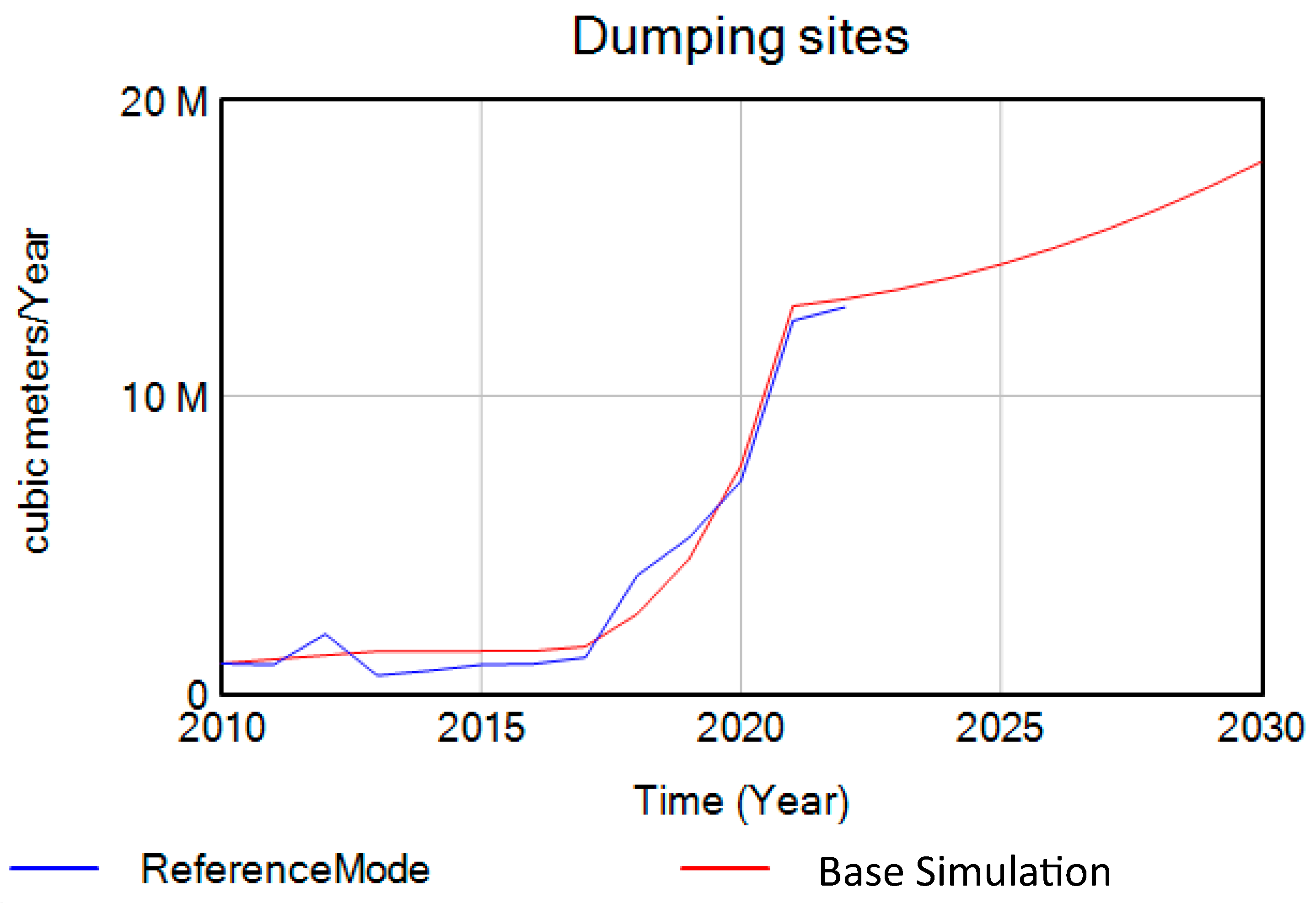

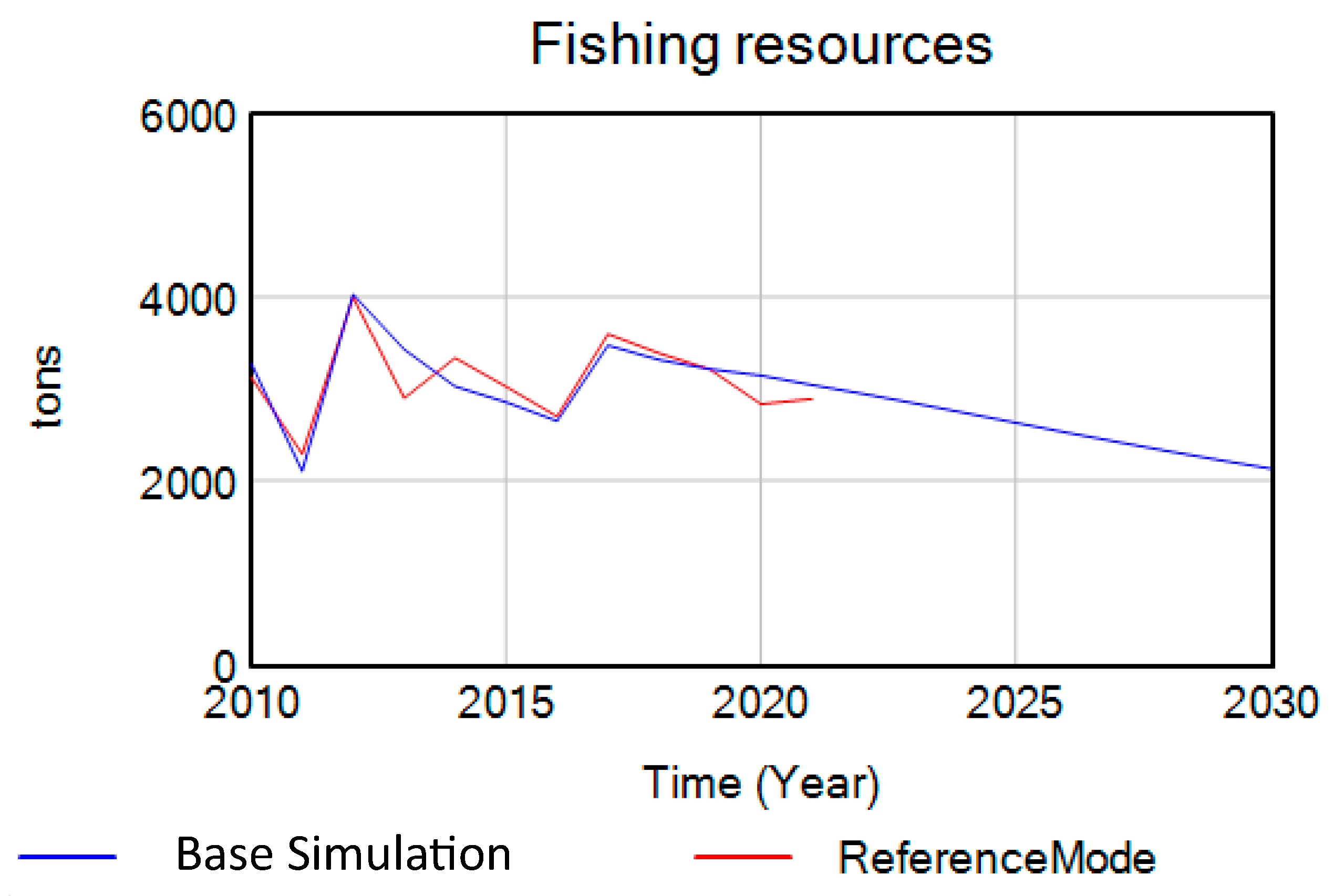
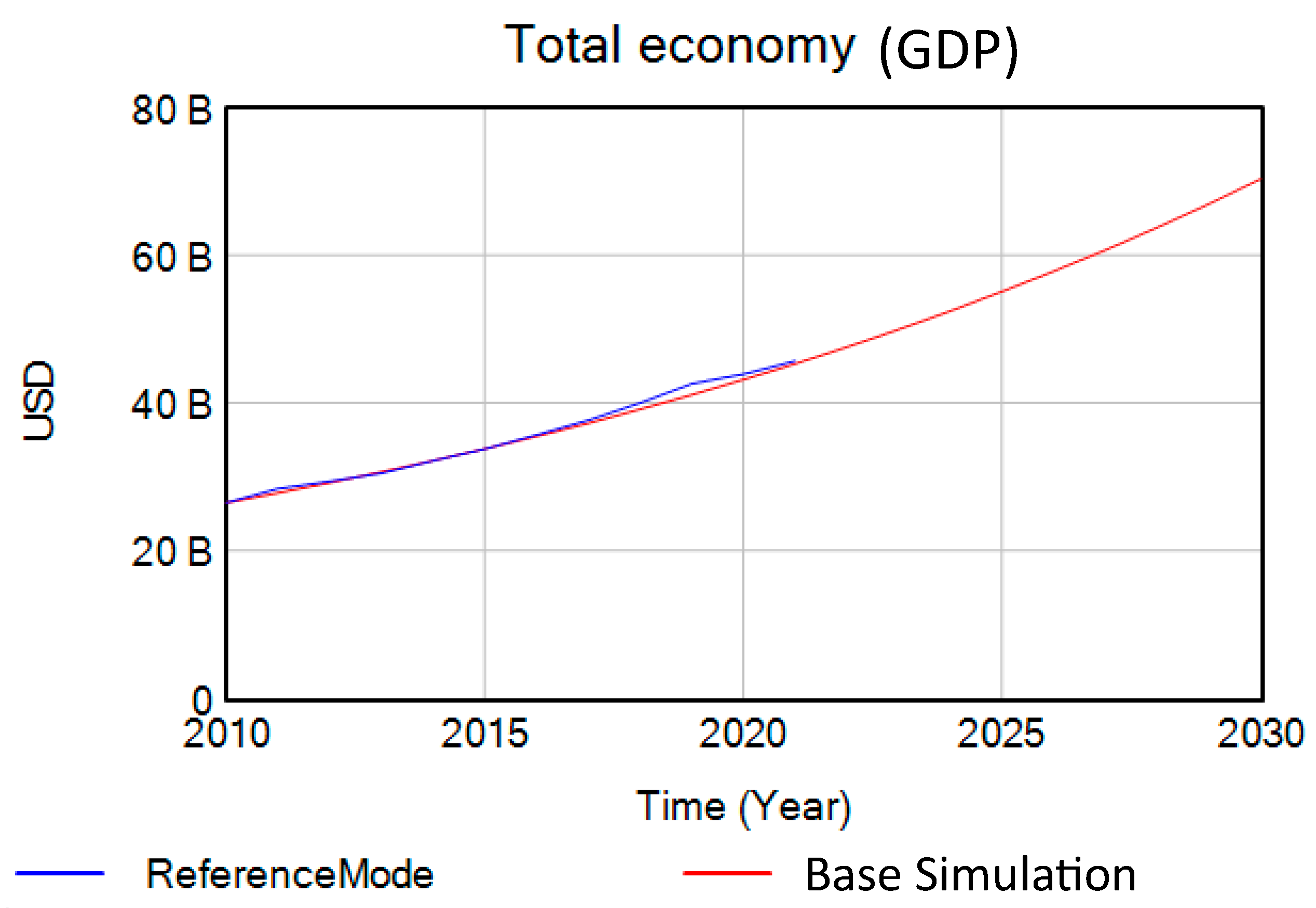
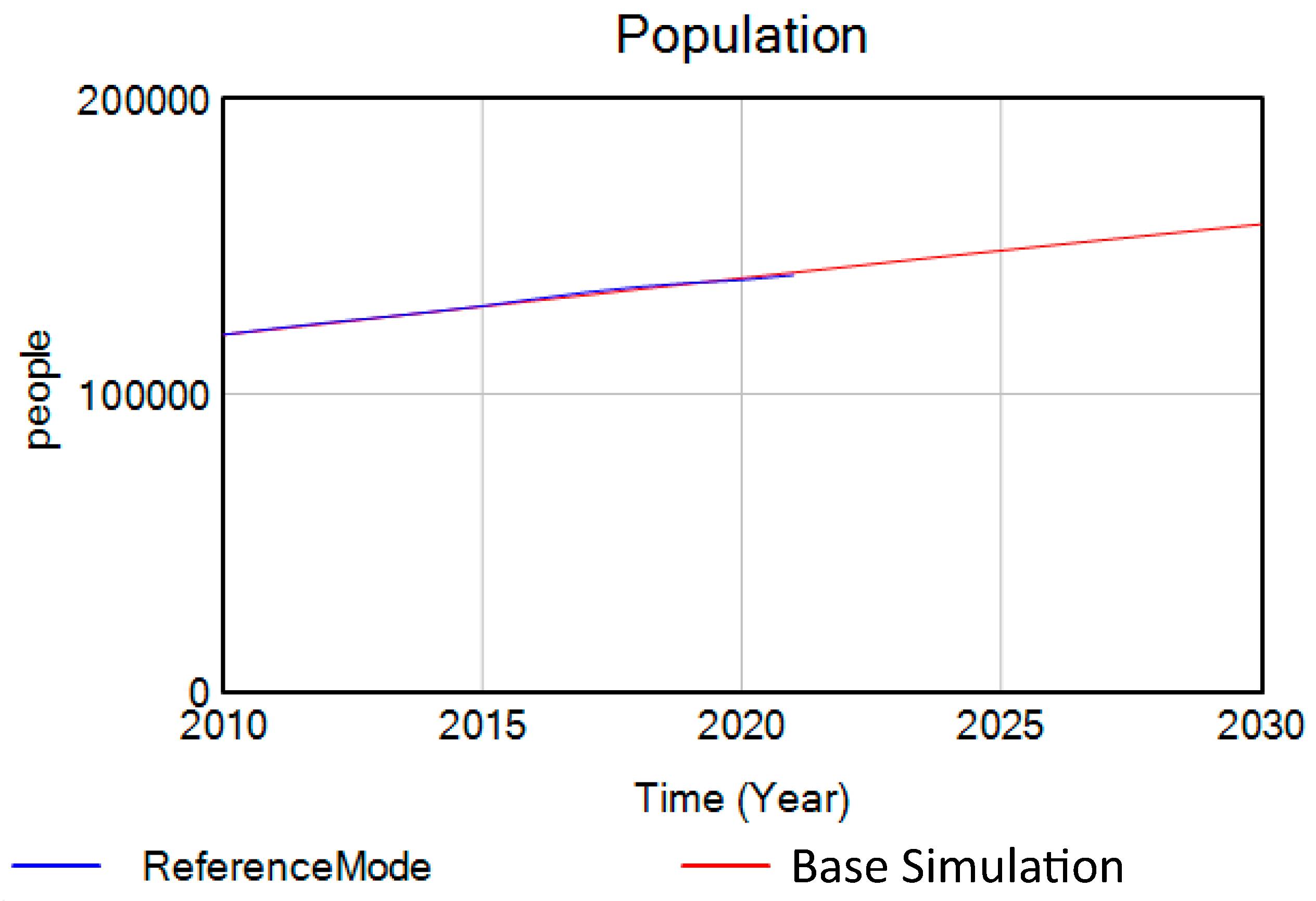



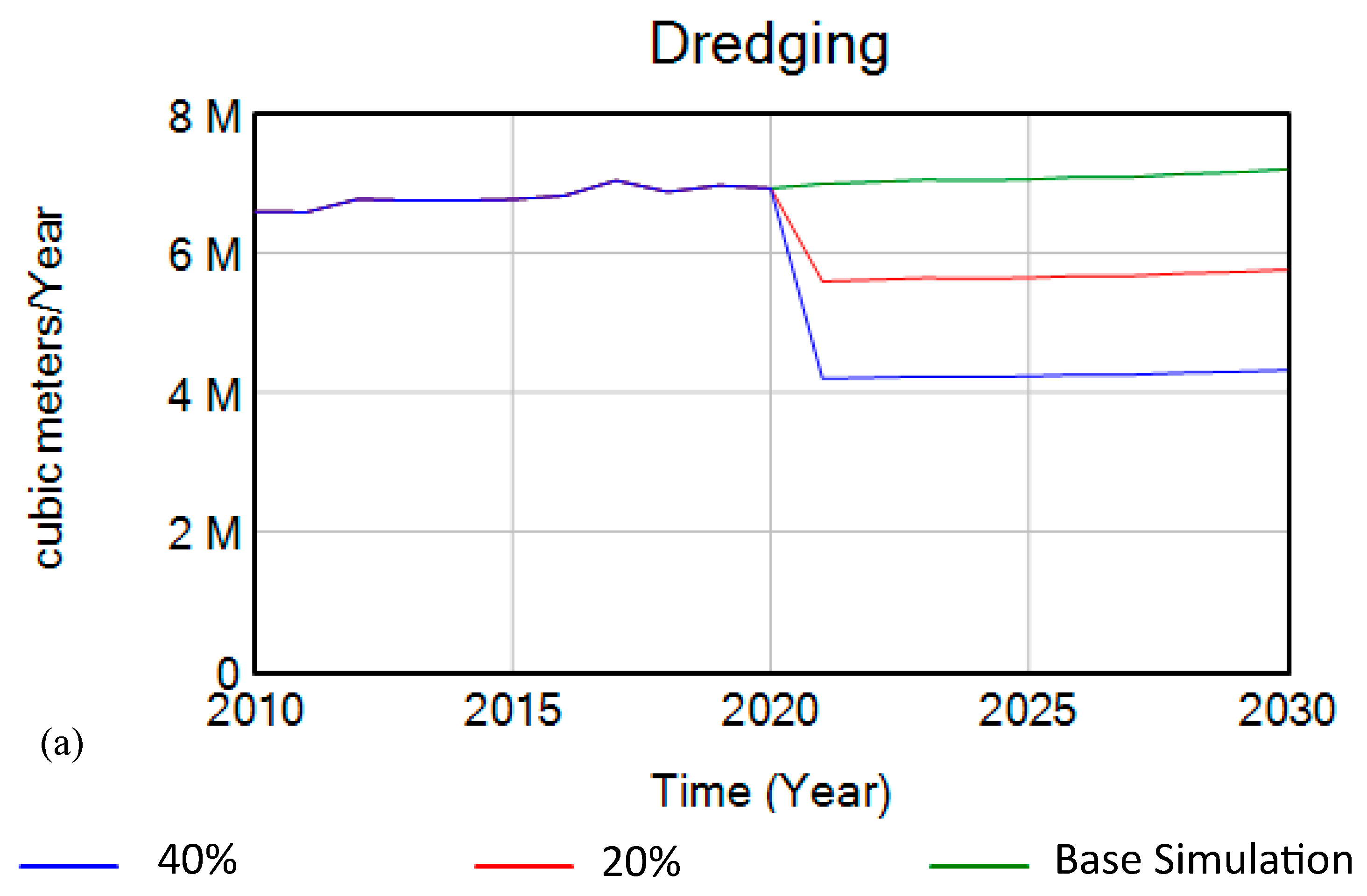
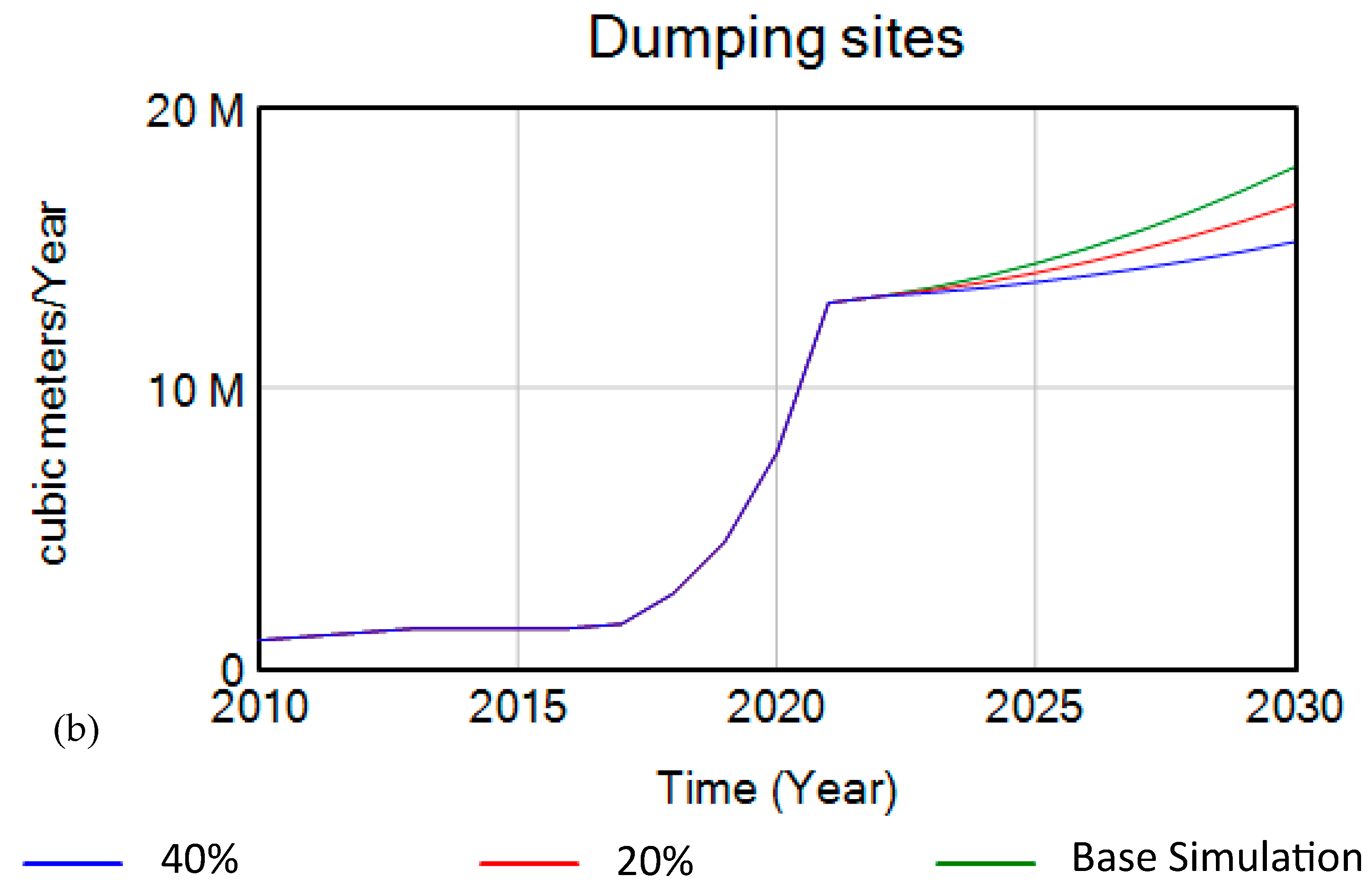
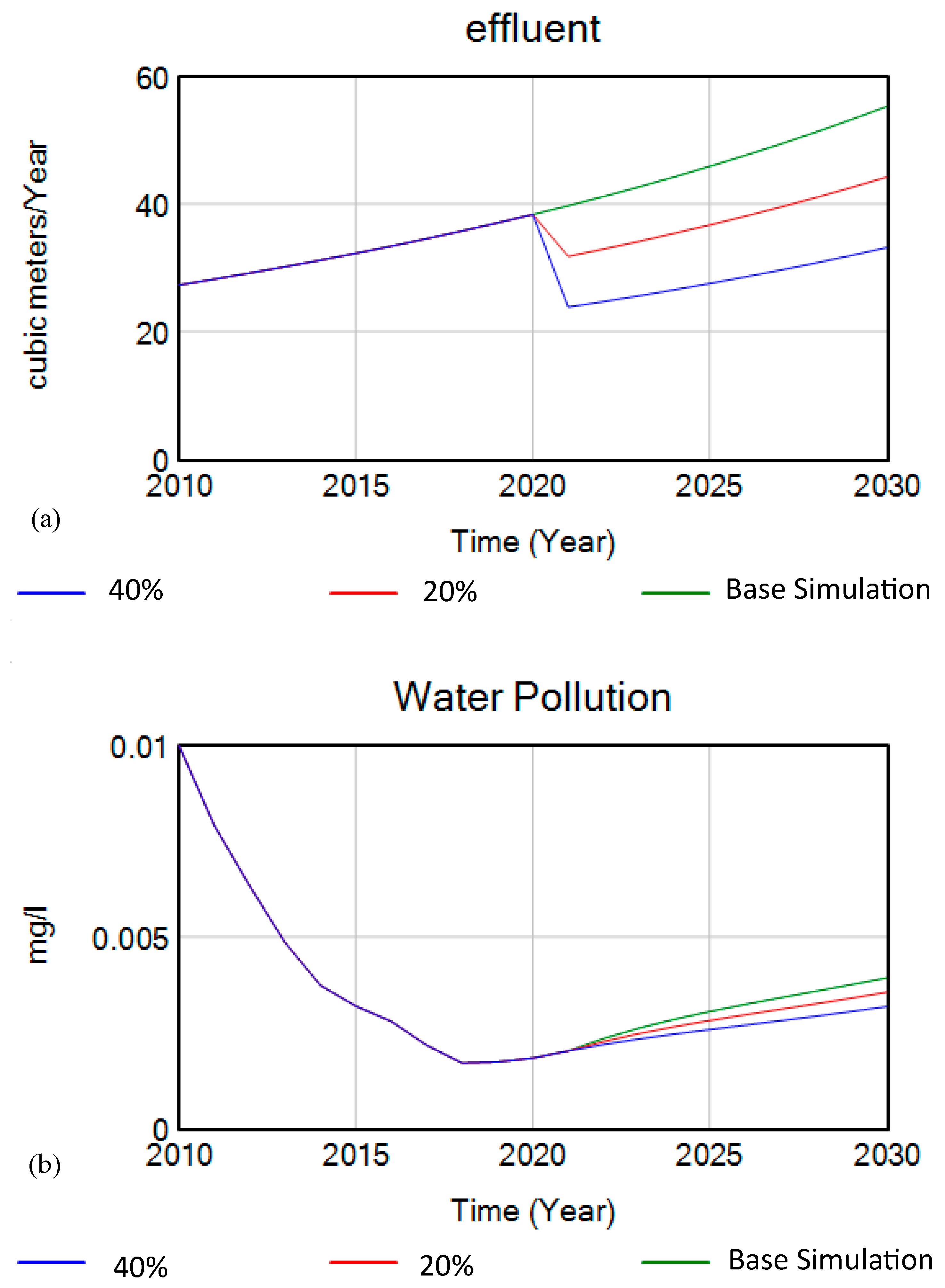
| Time (Year) | Historical Data (m3/Year) | Simulation (m3/Year) | Error (%) |
|---|---|---|---|
| 2010 | 986,659 | 986,659 | 0.00% |
| 2011 | 942,819 | 1.12 × 106 | 18.79% |
| 2012 | 1.98 × 106 | 1.76 × 106 | 11.11% |
| 2013 | 580,818 | 6.50 × 105 | 11.91% |
| 2014 | 741,968 | 8.90 × 105 | 19.95% |
| 2015 | 944,319 | 1.01 × 106 | 6.96% |
| 2016 | 973,934 | 1.03 × 106 | 5.76% |
| 2017 | 1.18 × 106 | 1.26 × 106 | 6.78% |
| 2018 | 3.95 × 106 | 3.65 × 106 | 7.59% |
| 2019 | 5.23 × 106 | 4.51 × 106 | 13.77% |
| 2020 | 7.15 × 106 | 7.67 × 106 | 7.27% |
| 2021 | 1.25 × 107 | 1.30 × 107 | 4.00% |
| 2022 | 1.30 × 107 | 1.33 × 107 | 2.31% |
| 2023 | - | 1.36 × 107 | - |
| 2024 | - | 1.40 × 107 | - |
| 2025 | - | 1.44 × 107 | - |
| 2026 | - | 1.50 × 107 | - |
| 2027 | - | 1.56 × 107 | - |
| 2028 | - | 1.63 × 107 | - |
| 2029 | - | 1.70 × 107 | - |
| 2030 | - | 1.79 × 107 | - |
| Time (Year) | Total Amount of Dumping: Base Simulation (m3/Year) | Total Amount of Dumping: 20% Reduced (m3/Year) | Total Amount of Dumping: 40% Reduced (m3/Year) |
|---|---|---|---|
| 2010 | 986,659 | 986,659 | 986,659 |
| 2011 | 1.12 × 106 | 1.12 × 106 | 1.12 × 106 |
| 2012 | 1.26 × 106 | 1.26 × 106 | 1.26 × 106 |
| 2013 | 1.40 × 106 | 1.40 × 106 | 1.40 × 106 |
| 2014 | 1.41 × 106 | 1.41 × 106 | 1.41 × 106 |
| 2015 | 1.41 × 106 | 1.41 × 106 | 1.41 × 106 |
| 2016 | 1.41 × 106 | 1.41 × 106 | 1.41 × 106 |
| 2017 | 1.56 × 106 | 1.56 × 106 | 1.56 × 106 |
| 2018 | 2.65 × 106 | 2.65 × 106 | 2.65 × 106 |
| 2019 | 4.51 × 106 | 4.51 × 106 | 4.51 × 106 |
| 2020 | 7.67 × 106 | 7.67 × 106 | 7.67 × 106 |
| 2021 | 1.3038 × 107 | 1.30 × 107 | 1.30 × 107 |
| 2022 | 1.33 × 107 | 1.33 × 107 | 1.33 × 107 |
| 2023 | 1.36 × 107 | 1.35 × 107 | 1.34 × 107 |
| 2024 | 1.40 × 107 | 1.38 × 107 | 1.36 × 107 |
| 2025 | 1.44 × 107 | 1.41 × 107 | 1.38 × 107 |
| 2026 | 1.50 × 107 | 1.45 × 107 | 1.40 × 107 |
| 2027 | 1.56 × 107 | 1.49 × 107 | 1.43 × 107 |
| 2028 | 1.63 × 107 | 1.54 × 107 | 1.45 × 107 |
| 2029 | 1.70 × 107 | 1.59 × 107 | 1.49 × 107 |
| 2030 | 1.79 × 107 | 1.65 × 107 | 1.52 × 107 |
| Time (Year) | Water Pollution: Base Simulation (mg/L) | Water Pollution: 20% Reduced (mg/L) | Water Pollution: 40% Reduced (mg/L) |
|---|---|---|---|
| 2010 | 0.01 | 0.01 | 0.01 |
| 2011 | 0.007905 | 0.007905 | 0.007905 |
| 2012 | 0.006326 | 0.006326 | 0.006326 |
| 2013 | 0.004851 | 0.004851 | 0.004851 |
| 2014 | 0.003734 | 0.003734 | 0.003734 |
| 2015 | 0.003195 | 0.003195 | 0.003195 |
| 2016 | 0.002796 | 0.002796 | 0.002796 |
| 2017 | 0.002173 | 0.002173 | 0.002173 |
| 2018 | 0.001705 | 0.001705 | 0.001705 |
| 2019 | 0.001738 | 0.001738 | 0.001738 |
| 2020 | 0.001835 | 0.001835 | 0.001835 |
| 2021 | 0.002022 | 0.002022 | 0.002022 |
| 2022 | 0.00235 | 0.00227 | 0.002191 |
| 2023 | 0.00262 | 0.002477 | 0.002334 |
| 2024 | 0.002851 | 0.002657 | 0.002463 |
| 2025 | 0.003054 | 0.002818 | 0.002582 |
| 2026 | 0.00324 | 0.002969 | 0.002698 |
| 2027 | 0.003415 | 0.003114 | 0.002813 |
| 2028 | 0.003586 | 0.003258 | 0.002931 |
| 2029 | 0.003757 | 0.003405 | 0.003053 |
| 2030 | 0.00393 | 0.003556 | 0.003183 |
Disclaimer/Publisher’s Note: The statements, opinions and data contained in all publications are solely those of the individual author(s) and contributor(s) and not of MDPI and/or the editor(s). MDPI and/or the editor(s) disclaim responsibility for any injury to people or property resulting from any ideas, methods, instructions or products referred to in the content. |
© 2023 by the authors. Licensee MDPI, Basel, Switzerland. This article is an open access article distributed under the terms and conditions of the Creative Commons Attribution (CC BY) license (https://creativecommons.org/licenses/by/4.0/).
Share and Cite
Mousavi, S.H.; Kavianpour, M.R.; Alcaraz, J.L.G.; Yamini, O.A. System Dynamics Modeling for Effective Strategies in Water Pollution Control: Insights and Applications. Appl. Sci. 2023, 13, 9024. https://doi.org/10.3390/app13159024
Mousavi SH, Kavianpour MR, Alcaraz JLG, Yamini OA. System Dynamics Modeling for Effective Strategies in Water Pollution Control: Insights and Applications. Applied Sciences. 2023; 13(15):9024. https://doi.org/10.3390/app13159024
Chicago/Turabian StyleMousavi, S. Hooman, M. R. Kavianpour, Jorge Luis García Alcaraz, and Omid A. Yamini. 2023. "System Dynamics Modeling for Effective Strategies in Water Pollution Control: Insights and Applications" Applied Sciences 13, no. 15: 9024. https://doi.org/10.3390/app13159024
APA StyleMousavi, S. H., Kavianpour, M. R., Alcaraz, J. L. G., & Yamini, O. A. (2023). System Dynamics Modeling for Effective Strategies in Water Pollution Control: Insights and Applications. Applied Sciences, 13(15), 9024. https://doi.org/10.3390/app13159024








